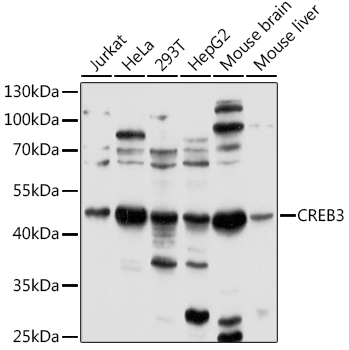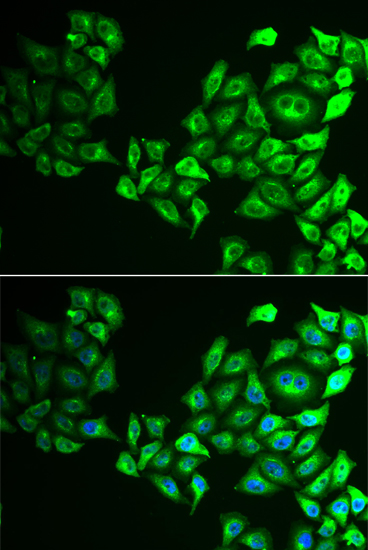-
Product Name
CREB3 Polyclonal Antibody
- Documents
-
Description
Polyclonal antibody to CREB3
-
Tested applications
WB, IF
-
Species reactivity
Human, Mouse
-
Alternative names
CREB3 antibody; LUMAN antibody; LZIP antibody; sLZIP antibody; cAMP responsive element binding protein 3 antibody
-
Isotype
Rabbit IgG
-
Preparation
Antigen: Recombinant fusion protein containing a sequence corresponding to amino acids 1-230 of human CREB3 (NP_006359.3).
-
Clonality
Polyclonal
-
Formulation
PBS with 0.02% sodium azide, 50% glycerol, pH7.3.
-
Storage instructions
Store at -20℃. Avoid freeze / thaw cycles.
-
Applications
WB 1:500 - 1:2000
IF 1:10 - 1:100 -
Validations

Western blot - CREB3 Polyclonal Antibody
Western blot analysis of extracts of various cell lines, using CREB3 antibody at 1:1000 dilution.Secondary antibody: HRP Goat Anti-Rabbit IgG (H+L) at 1:10000 dilution.Lysates/proteins: 25ug per lane.Blocking buffer: 3% nonfat dry milk in TBST.Detection: ECL Basic Kit .Exposure time: 10s.

Immunofluorescence - CREB3 Polyclonal Antibody
Immunofluorescence analysis of HeLa cells using CREB3 antibody . Blue: DAPI for nuclear staining.
-
Background
Endoplasmic reticulum (ER)-bound sequence-specific transcription factor that directly binds DNA and activates transcription. Plays a role in the unfolded protein response (UPR), promoting cell survival versus ER stress-induced apoptotic cell death. Also involved in cell proliferation, migration and differentiation, tumor suppression and inflammatory gene expression. Acts as a positive regulator of LKN-1/CCL15-induced chemotaxis signaling of leukocyte cell migration. Associates with chromatin to the HERPUD1 promoter. Also induces transcriptional activation of chemokine receptors.; Processed cyclic AMP-responsive element-binding protein 3: This is the transcriptionally active form that translocates to the nucleus and activates unfolded protein response (UPR) target genes during endoplasmic reticulum (ER) stress response. Binds the cAMP response element (CRE) (consensus: 5'-GTGACGT[AG][AG]-3') and C/EBP sequences present in many promoters to activate transcription of the genes. Binds to the unfolded protein response element (UPRE) consensus sequences sites. Binds DNA to the 5'-CCAC[GA]-3'half of ERSE II (5'-ATTGG-N-CCACG-3').; Isoform 2: Functions as a negative transcriptional regulator in ligand-induced transcriptional activation of the glucocorticoid receptor NR3C1 by recruiting and activating histone deacetylases (HDAC1, HDAC2 and HDAC6). Also decreases the acetylation level of histone H4. Does not promote the chemotactic activity of leukocyte cells.; (Microbial infection) Plays a role in human immunodeficiency virus type 1 (HIV-1) virus protein expression.; (Microbial infection) Isoform 1: Plays a role in herpes simplex virus-1 (HSV-1) latent infection and reactivation from latency. Represses the VP16-mediated transactivation of immediate early genes of the HSV-1 virus by sequestering host cell factor-1 HCFC1 in the ER membrane of sensory neurons, thereby preventing the initiation of the replicative cascade leading to latent infection.; (Microbial infection) Isoform 1: May play a role as a cellular tumor suppressor that is targeted by the hepatitis C virus (HCV) core protein.; (Microbial infection) Processed cyclic AMP-responsive element-binding protein 3: Activates transcription of genes required for reactivation of the latent HSV-1 virus. It's transcriptional activity is inhibited by CREBZF in a HCFC1-dependent manner, by the viral transactivator protein VP16. Binds DNA to the cAMP response element (CRE) (consensus: 5'-GTGACGT[AG][AG]-3') and C/EBP sequences present in many viral promoters.; (Microbial infection) Processed cyclic AMP-responsive element-binding protein 3: It's transcriptional activity is inhibited by CREBZF in a HCFC1-dependent manner, by the viral transactivator HCV core protein.
Related Products / Services
Please note: All products are "FOR RESEARCH USE ONLY AND ARE NOT INTENDED FOR DIAGNOSTIC OR THERAPEUTIC USE"
